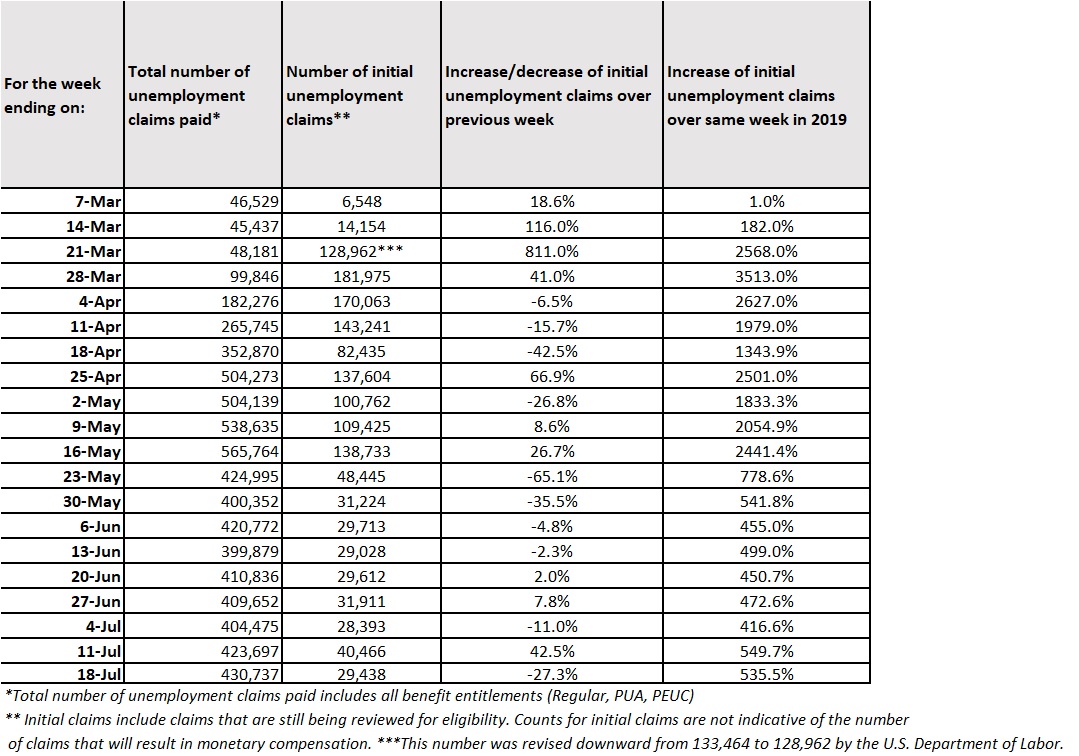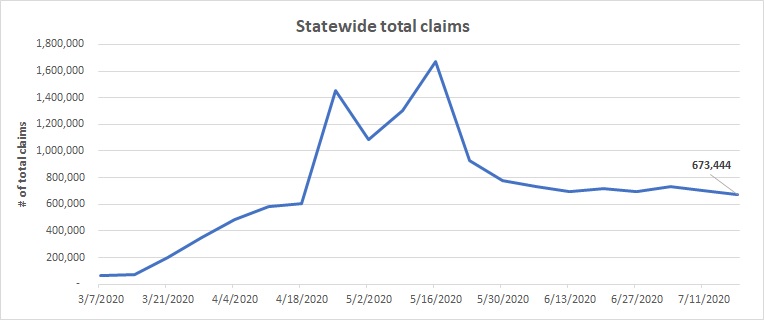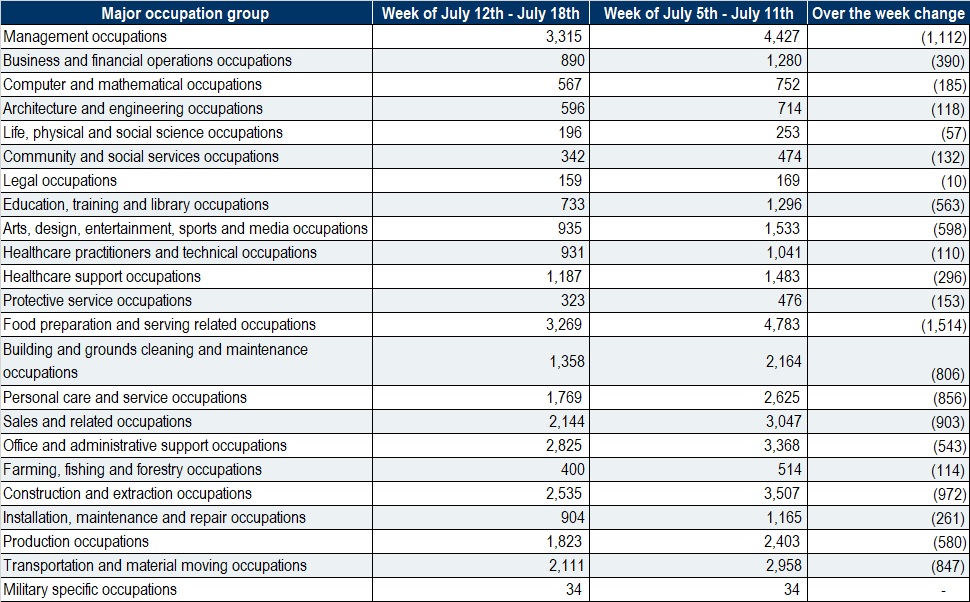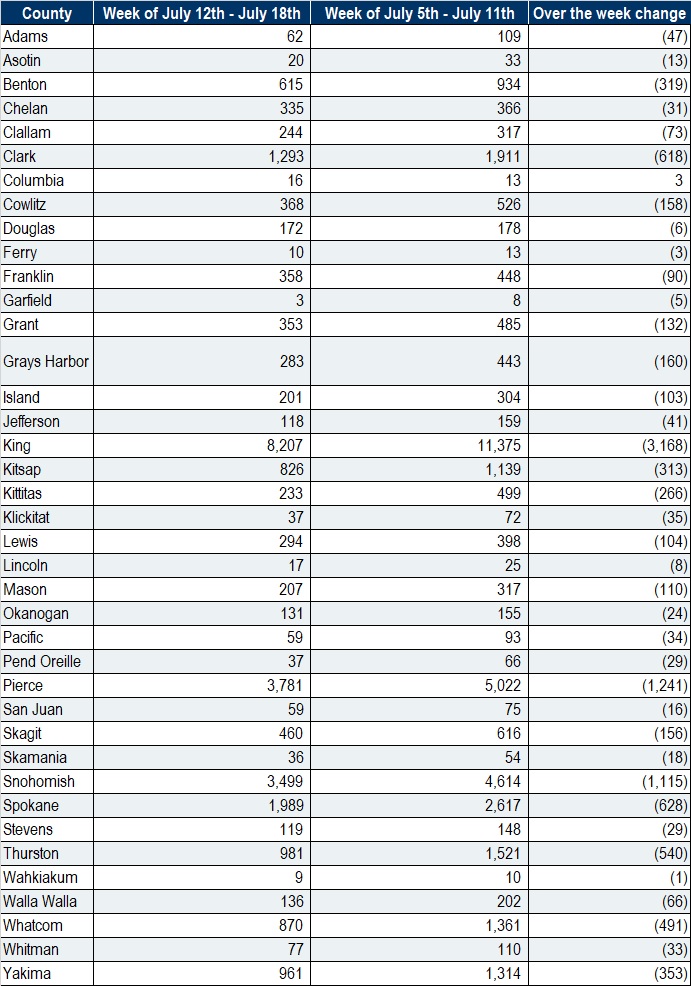Initial unemployment insurance claims for week of July 12-18, 2020
Employment Security Department
20-039
FOR IMMEDIATE RELEASE – July 23, 2020
CONTACTS
Media inquiries: media@ESD.WA.GOV
Initial regular claims for unemployment benefits decrease from the previous week
OLYMPIA – During the week of July 12 through July 18, there were 29,438 initial regular unemployment claims (down 27.3% from the prior week) and 673,444 total claims for all unemployment benefit categories (down 4.7% from the prior week) filed by Washingtonians, according to the Employment Security Department (ESD).
- Initial regular claims applications remain at unprecedented elevated levels and are at 536 percent above last year’s weekly new claims applications.
- Pandemic Unemployment Assistance (PUA), Pandemic Emergency Unemployment Compensation (PEUC) initial claims as well as continued/ongoing claims all decreased over the previous week.
ESD paid out over $493.6 million for 430,737 individual claims – an increase of $4.8 million and 7,193 more individuals compared to the prior week.
|
Unemployment claim type |
Week of July 12-July 18 |
Week of July 5-July 11 |
Week of June 28-July 4 |
|
Regular Unemployment Insurance (UI) initial claims |
29,438 |
40,466 |
28,393 |
|
Pandemic Unemployment Assistance (PUA) initial claims |
6,827 |
9,349 |
10,058 |
|
Pandemic Emergency Unemployment Compensation (PEUC) initial claims |
7,177 |
9,573 |
10,020 |
|
Continued/ongoing weekly claims |
630,092 |
646,921 |
687,680 |
|
Total claims |
673,444 |
706,309 |
736,151 |
Since the week ending March 7 when COVID-19 job losses began:
- A total of 2,311,878 initial claims have been filed during the pandemic (1,457,223 regular unemployment insurance, 458,034 PUA and 396,621 PEUC)
- A total of 1,271,260 distinct individuals have filed for unemployment benefits
- ESD has paid out over $8.1 billion in benefits
- 945,044 individuals who have filed an initial claim have been paid
“This past week, for the first time since the pandemic began, all initial claim types as well as continued and ongoing weekly claims decreased,” said ESD Commissioner, Suzi LeVine. “We are making excellent progress on our efforts to resolve the claims for those who have been waiting the longest, having reduced that backlog by nearly 75 percent. And for those looking to return to work, or who cannot yet return due to the crisis, I encourage you to check out the return to work and refusal of work pages on our website for the latest information. Both job seekers and employers should also go to WorkSourceWa.com for job postings, employment resources in your local community, and for virtual services – including virtual job fairs, which directly connect job seekers and employers across the state.”
Below is a twenty-week summary of statewide initial claims filed since the start of the COVID-19 crisis:



Weekly data breakdown
By industry
Industry sectors experiencing the highest number of initial claims during July 12- July 18 were:
- Accommodation and food services: 2,987 initial regular claims, down 1,547 (-34 percent) from previous week
- Health care and social assistance: 2,902 initial regular claims, down 483 (-14 percent) from the previous week
- Manufacturing: 2,480 regular initial claims, down 472 (-16 percent) from the previous week
- Retail trade: 2,339 initial regular claims, down 684 (-23 percent) from previous week
- Construction: 2,217 initial regular claims, down 509 (-19 percent) from the previous week
By occupation
- Management occupations: 3,315 regular initial claims, down 1,112 (-25 percent) from the previous week
- Food preparation and serving: 3,269 regular initial claims, down 1,514 (-32 percent) from previous week
- Office and administrative support: 2,825 regular initial claims, down 543 (-16 percent) from previous week
- Construction and extraction occupations: 2,535 regular initial claims, down 972 (-28 percent) from the previous week
- Sales and related occupations: 2,144 regular initial claims, down 903 (-30 percent) from the previous week
By county
King County, the most populous in the state saw initial regular claims decrease from 11,375 to 8,207 during the week of July 12- July 18, down 28 percent from the week before.
Other counties with the largest number of initial claims during the week were:
- Pierce County: Initial regular claims filed decreased from 5,022 to 3,781 down 25 percent from the week before.
- Snohomish County: Initial regular claims filed decreased from 4,614 to 3,499 down 24 percent from the week before.
- Spokane County: Initial regular claims filed decreased from 2,617 to 1,989 down 24 percent from the week before.
- Clark County: Initial regular claims filed decreased from 1,911 to 1,293 down 32 percent from the week before.
Demographic breakdown – complete charts are provided in Appendix A below (This information is asked during the application process).
During the week of July 12- July 18:
- By gender: 50.3 percent (14,752) of the initial regular claims were filed by females while 49.3 percent (14,467) were filed by males
- By age group: 27.5 percent (8,068) of initial regular claims were filed by the 25-34 years old age group, followed by 21.2 percent (6,208) by the 35-44 years old age group and 16.7 percent (4,905) by the 45-54 years old age group.
- By education level: 31.4 percent (9,206) of initial regular claims were filed by individuals with a high school diploma, included GED, followed by 24.4 percent (7,164) with some college and 14.7% (4,306) with a bachelor’s degree.
- By race/ethnicity: 59.8 percent (17,552) of initial regular claims were filed by Caucasians, followed by 7.8 percent (2,303) filed by Asians, 6.8 percent filed by Black/African Americans (2,006) and 6.4 percent filed by Latino/Hispanics (1,873).
- By disability status: 3.2 percent (951) of initial regular claims were from individuals identified as having a disability, including 0.7 percent (220) who identified themselves as disabled veterans.
- By veteran’s status: 4.9 percent (1,426) of initial regular claims were filed by veterans, including 144 initial regular claims from individuals eligible for veterans benefits due to family relations with a veteran.
SharedWork
For employers looking to avoid layoffs or slowly ramp up re-hiring during this crisis, SharedWork is a great program that can help. You can learn more at esd.wa.gov/SharedWork
|
|
Week of July 12-18 |
Week of July 5 - 11 |
During height of the recession |
|
Employers with an approved SharedWork plan |
3,416 employers covering 151,195 employees |
3,403 employers covering 151,370 employees |
2,500 employers covering approximately 46,000 employees |
|
Individuals who filed weekly claims for the SharedWork program |
64,385
|
60,525 |
46,000 |
Please see new charts in the Appendix A below. For complete information of weekly initial claims by industry sector and county for the year to date, also check the weekly unemployment initial claims charts compiled by ESD’s Labor Market & Economic Analysis division. For more information about specific counties, contact one of ESD’s regional local economists.
NOTE: ESD will send out the next weekly new claims press release on Thursday, July 30 at 10 a.m. Pacific Time.
Data disclaimer and definitions
Per U.S. Department of Labor regulations, weekly unemployment claims data is embargoed and not available for release until the Thursday following the claim week.
Initial claims include individuals who filed first-time claims as well as additional claims filed by individuals as a result of a new unemployment event. Initial claims include claims that are still being reviewed for eligibility. Counts for initial claims are not indicative of the number of claims that will result in monetary compensation.
Continuing claims equal continued weeks claimed including a total of all weeks for which benefits were claimed, even though such benefits were not paid or payment status is uncertain or unknown, e.g., waiting weeks, partial weeks, weeks for which penalties are being served and weeks for which a monetary or nonmonetary issue is pending.
Pandemic Unemployment Assistance (PUA) is an emergency program established by the federal CARES Act that temporarily expands unemployment insurance eligibility to self-employed workers, freelancers, independent contractors, and part-time workers impacted by the coronavirus pandemic in 2020.
Pandemic Emergency Unemployment Compensation (PEUC) is an emergency program established by the federal CARES Act that extends unemployment insurance for an extra 13 weeks to those who have exhausted their regular unemployment benefits.
Federal Pandemic Unemployment Compensation (FPUC) is an emergency program established by the CARES Act to increase unemployment benefits for Americans who are out of work because of the COVID-19 pandemic. Under FPUC, eligible people who collect certain unemployment insurance benefits—including regular unemployment compensation—will get an extra $600 in federal benefits each week through the week ending July 25, 2020. They do not need to file a separate claim to receive this money, it is automatically added to their payment.
COVID-19 resources
State of Washington’s coronavirus website
Washington state Department of Health public health resources
Labor market web links
- Labor market information website
- Historical data(Excel spreadsheet)
- Current claims data
- Historical claims data(Excel spreadsheets)
Appendix A
Initial regular claims by industry

Initial regular claims by occupation

Initial regular claims by county

Initial regular claims by gender

Initial regular claims by age group

Initial regular claims by race/ethnicity

Initial regular claims by Veteran status

Initial regular claims by disability status

Initial regular claims by education level
